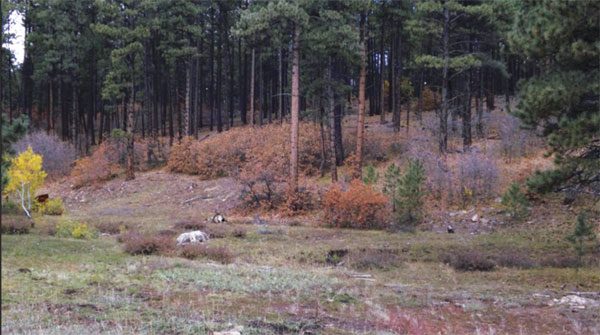
This photo from Haycamp Mesa in the San Juan National Forest shows open forest drainage with grass and forbs in the bottom, next to a hillside of dense tree cover, without green grass or forbs. Photo by Dexter Gill.
You are walking through the forest, scouting for interesting wildlife when suddenly — there, on the edge of a little clearing, you see them. A doe mule deer with twin fawns, one nursing as the other explores its new world. You want to get a picture but too many trees are in the way so you carefully creep forward and suddenly CRUNCH! and the deer bolt out of sight.
You look down and see that you are walking on a mat of dry pine needles and aspen leaves. Rats, if this was green grass I would have been able to walk right up on them. Why is there no grass here, but there is where the deer were? Remember, you were in a thicket of trees and the deer were in an opening.
Grass and forbs (flowering plants) need lots of sunshine and water to thrive. In the thick forests, the trees take in the light and shade out the grasses and forbs, leaving only the continuous buildup of pine needles and leaves, which also prevent the seeds of grasses and forbs from taking root. Wildlife like open areas where the grasses and forbs are able to grow with adequate sunlight and water for their food.
Ever wonder why you see deer and elk near roadways and highways? Food, glorious food! I knew of some old-timers that would go elk hunting on horseback and tie a cowbell on the horse. Back then some ranchers would “bell” the lead cows in a herd. The cows were always where there was good forage and water that the rancher had worked up. So the hunter could ride right into the elk, which had learned there was food and water where the bell was heard.
The elk were just like some people, always looking for an easy meal, which is why they are in ranchers’ and farmers’ haystacks and fields in the winter. Wildlife have their own GPS systems that are programed for wherever man has prepared special meals for them, since nature has not done near as well as man has. It’s not even potluck, just bring their appetite. As you might guess, this can create somewhat of a problem.
Why isn’t there more forage in the forest to feed them there? There used to be, but things have changed. The forest has been allowed to become overgrown, with way too many trees for its own good. The trees have shaded out the grasses and also greatly reduced the amount of rain and snow that reaches the ground, as the trees are fighting each other for sunlight and water. So if you want more wildlife food you must drastically thin out the trees, and of course that costs money, so you need to find an economical use for the trees that will pay for the thinning.
The question comes up, just how much grass and forbs are needed to feed elk, which is what people are screaming they want more of and better access to hunt? Well, the average elk will eat about 3 pounds of forage per 100 pounds of weight. So a 600-pound elk would need 18 pounds of grass per day, plus water to process it.
I challenge you to get your clippers and go out in the forest thicket area and clip grass and forbs until you have 18 pounds and see how much ground you have covered. Now multiply that by a small herd of only 20, although winter herds can be 200-400 head. The 20 head of elk would need 360 pounds every day. That is over 2,000 two-wire bales of hay per year, or 100 bales per each elk per year.
So where is the grass? Mostly in stream bottoms, open swales and private farmlands. The stream bottoms and swales on public lands are over-used because that is where the forage is, since there has been little to no thinning and management of trees on the rest of the forest.
Hunters want more elk on public lands for free hunting. Free is nice, but remember, nothing is free; somebody pays. To provide forage, the forest must be thinned out. The wilderness advocates and so-called “quiet users” don’t want trees cut or any management action necessary to improve and sustain the forest, but do want to see elk and other wildlife numbers and conditions improve. Quite the conundrum! You can hear the forest vegetation screaming out to be cared for, healed, used, reproduced and given a productive future of forage, water and wood products, for man and wildlife. Is anyone listening? Are they going to do anything?
If you want better “free” hunting and recreation on public lands, the forest must be restored to a healthy condition with more diversity, quality and quantity of trees, shrubs, grasses and forbs. That can be done only by returning to management using wood products and livestock industries to accomplish the work. Those industries will have to be restored as well, for it all to take place.
Where is the grass? Not where it should and could be!
Dexter Gill is a retired forest manager who worked for private industry, three Western state forestry agencies, and the Navajo Nation forestry department. He writes from Lewis, Colo.

